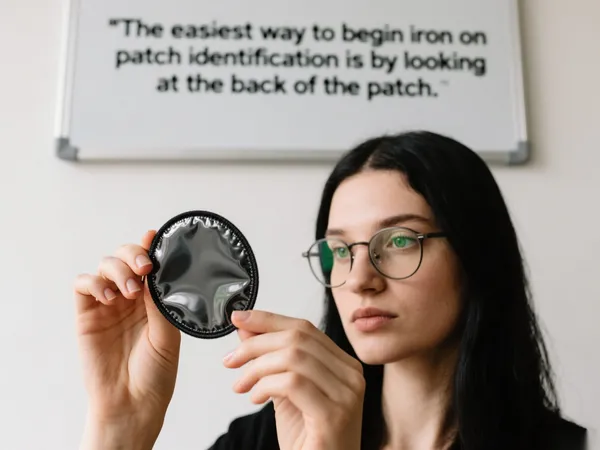Iron-on patches are a convenient and stylish way to customize clothing, bags, and accessories—but not all patches are created equal. Whether you’re looking at a patch you’ve bought online or found in a craft drawer, you might be wondering: How do you know if a patch is iron on?
Knowing the difference between iron-on and sew-on patches is essential before attempting to apply one. Using heat on the wrong type can damage both the patch and your garment. In this article, we’ll cover the telltale signs of iron on patch identification, simple tests you can do at home, and tips to help you avoid common mistakes.

ما هي رقعة المكواة؟
أن iron-on patch has a special adhesive backing that melts under heat and bonds to fabric. Unlike sew-on patches, which require stitching, iron-ons can be attached with a household iron in just minutes. This makes them popular for quick DIY clothing customization.
But without packaging or instructions, how can you identify if a patch is iron-on?
1. Check the Back of the Patch
The easiest way to begin iron on patch identification is by looking at the back of the patch:
- Shiny or Glossy Backing: Iron-on patches typically have a smooth, glossy surface on the back. This layer is the heat-activated adhesive.
- Plastic-like Texture: You might feel a slightly rubbery or plastic coating if you run your fingers across the backing.
- Paper Cover Sheet (Sometimes): Some iron-on patches come with a peel-off paper layer protecting the glue underneath.
If the back looks like plain fabric with stitching and no coating, it’s most likely a sew-on patch.

2. Perform a Simple Heat Test (With Caution)
If you’re still unsure and the patch isn’t valuable or irreplaceable, you can try a careful heat test:
- Set your iron to medium heat (no steam).
- Place the patch (adhesive side down) on a scrap piece of fabric.
- Cover it with a thin cloth and press the iron for 10–15 seconds.
- Let it cool, then lift the cloth and check: if the patch sticks, even partially, it’s iron-on.
⚠️ Be cautious—using too much heat or testing on delicate materials may damage the patch or fabric. Always test on an inconspicuous area first.
3. Look for Manufacturer Details
If you bought your patch online or in a store, check the product label or listing. Phrases like:
- “Iron-on backing”
- “Heat seal patch”
- “No sewing required”
…all indicate it’s designed for iron-on use. If it says “sew-on only” or doesn’t mention heat application at all, chances are it’s not meant for ironing.
Some patches are even hybrid—they include both an adhesive layer and stitch guide for extra durability.
4. Compare to Known Iron-On Patches
If you have another iron-on patch you’re confident about, place the two side-by-side and inspect their backings. You’ll often notice:
- Color differences in the glue layer (usually off-white or slightly yellow)
- Differences in stiffness—iron-on patches tend to be slightly stiffer due to the adhesive
Having a reference point can help with how to tell if a patch is iron on when you’re unsure.

5. Ask the Seller or Manufacturer
Still can’t figure it out? If your patch came from an online seller, don’t hesitate to contact them. Reputable patch manufacturers often have customer service or FAQs that describe the patch type and application method.
You can ask specifically:
- “Is this patch iron-on or sew-on?”
- “Does it have heat-activated adhesive?”
- “What’s the best way to apply this patch?”

6. Bonus Tip: Look for Melting or Curling Edges After Ironing
If you’ve accidentally ironed on a patch without knowing the type, you may notice:
- Edges curling up or burning – likely not meant to be ironed
- Patch sticks partially but peels off easily – low-quality iron-on or needs reinforcement
- Patch melts or discolors – definitely not iron-on
In such cases, it’s better to hand-sew or machine-stitch the patch for safety and longevity.
Conclusion: Identify Before You Apply
When asking, “How do you know if a patch is iron on,” the answer lies in careful observation and a little bit of testing. The back surface, texture, packaging, and even a cautious heat test can reveal whether you’re dealing with an iron-on patch.
With proper identification, you can confidently apply your patch using the right method—and ensure it stays securely in place for years to come. Whether you’re doing DIY fashion or fixing uniforms, getting this step right makes all the difference.



